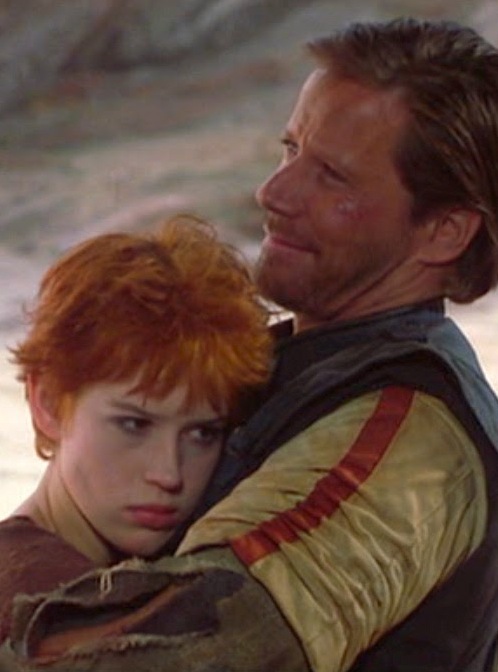Thursday, June 2, 1983
SPACEHUNTER: ADVENTURES IN THE FORBIDDEN ZONE. Written by Edith Rey, David Preston, Dan Goldberg and Len Blum. Based on a story by Stewart Harding and Jean Lafleur. Music by Elmer Bernstein. Directed by Lamont Johnson. Running time: 88 minutes. Mature entertainment with the B.C. Classifier's warning: some violence, occasional suggestive language and swearing.
DRIVE-IN PATRONS ARE actually getting a better deal. The flat projection on the outdoor screen is the one place where one can actually see Spacehunter: Adventures in the Forbidden Zone, a moderately entertaining movie, made difficult to enjoy in all other locations because of some unexpectedly bad 3-D.
A competent space opera, it is designed to appeal to the folk who think Han Solo is the most interesting character in Star Wars. Here the hero is Wolff (Peter Strauss), a freelance adventurer who specializes in salvage and has great faith in his blaster.
A distress call attracts Wolff to Terra Eleven, a plague-infested planet upon which three shipwrecked Earth women have been lost. Would't you know it. Those fiends in the forbidden zone's Graveyard City have made prisoners of the beautiful Nova (Cali Timmins), Reena (Aleisa Shirley) and Meagan (Deborah Pratt).
Ruling over this technological leper colony is Overdog, yet another villainous role for Michael Ironside, the Canadian actor who sure blowed up good at the end of director David Cronenberg's Scanners (1981). Here he plays a half-man, half-machine, all-mad scientist who entertains his followers by forcing their prisoners to run through a deadly maze.
Wolff assaults Overdog's scrapheap stronghold aided by Niki (Molly Ringwald), the bratty, teenaged survivor of a previous rescue mission, and Washington (Ernie Hudson), the somewhat inept local Sector Chief. Although the acting is broad, the production design team has come through with a suitably creepy alien world for them to investigate.
The major achiever here is Elmer Bernstein. Perhaps conscious of the fact that his composer colleagues John (Star Wars; Superman) Williams and Jerry (Alien; Star Trek) Goldsmith were getting all the plum science-fictional assignments, he demonstrates his ablity to pen a first-rate musical score.
Unfortunately, all the film's good points are lost in the struggle with Frank Tidy's stereoscopic photography.
Unlike most recent 3-D movie directors, 60-year-old Lamont Johnson displays no desire to use depth-effect gimmickry. In many instances, he seems to go out of his way to ignore the legitimate dramatic possibilities of the technology.
As if that weren't bad enough, the film's Canadian distributor is not paying much attention to quality control. The print that I saw included footage with double (or "ghost") images far too frequently for it to have been anything but indifference to the product coming out of the laboratory.
I really think Spacehunter might have done just fine without all the 3-D nonsense. I know I could have done without the headache that shoddy 3-D causes.
The above is a restored version of a Province review by Michael Walsh originally published in 1983. For additional information on this archived material, please visit my FAQ.
Afterword: Spacehunter has been available on DVD since 2001. Looking at it 32 years later (without the headache-inducing 3-D), I found a lot to like in Canadian producer Ivan Reitman's first made-in-B.C. feature film. True, the Mad Max-meets-Star Wars plot made no sense at all. The various encounters with bat men and barracuda women recall the classic nuttiness of 1968's Barbarella, while the appearance of actor Ernie Hudson along with a voice performance by Harold Ramis (heard on an intercom), looked ahead to Reitman's wonderfully antic Ghostbusters (1984). The Canadian screenwriting team seem to have taken the whole thing as an opportunity for comedy, and the result is infused with insouciant, adolescent energy. Though the picture was a rare feature-film starring role for television actor Peter Strauss, it was our introduction to the 15-year-old Molly Ringwald, who broke through a year later in director John Hughes's Sixteen Candles (1984).
During more than 40 years as a director, California-born Lamont Johnson had little contact with science fiction. Aside from directing eight episodes of Rod Serling's original Twilight Zone TV series in the early 1960s, he only did two sci-fi movies, both of them on visits to Vancouver. The first was The Groundstar Conspiracy (1972), today remembered as a landmark in the establishment of Vancouver as Hollywood North. He returned for Spacehunter, notable as the first 3-D feature filmed in B.C. (and the second in Canada, coming 22 years after Julian Roffman's Toronto-made The Mask).
But wait, there's more. Included among Spacehunter's supporting players was Deborah Pratt, a Chicago-born television actress making her feature-film debut in the role of Meagan, one of the three young women marooned on Terra Eleven. A year after Spacehunter's release, she married U.S. television producer Donald P. Bellisario, the creator of the five-season Quantum Leap series for NBC. On screen, she was heard as the voice of Ziggy, the supercomputer that ran Project Quantum Leap. Behind the scenes, she was one of the show's producers and the writer of 20 of Quantum Leap's 97 episodes. Pratt found her way back to Vancouver as the creator of The Net, the 1999 television series about cyberterrorism shot on location in B.C. for the USA cable network.
